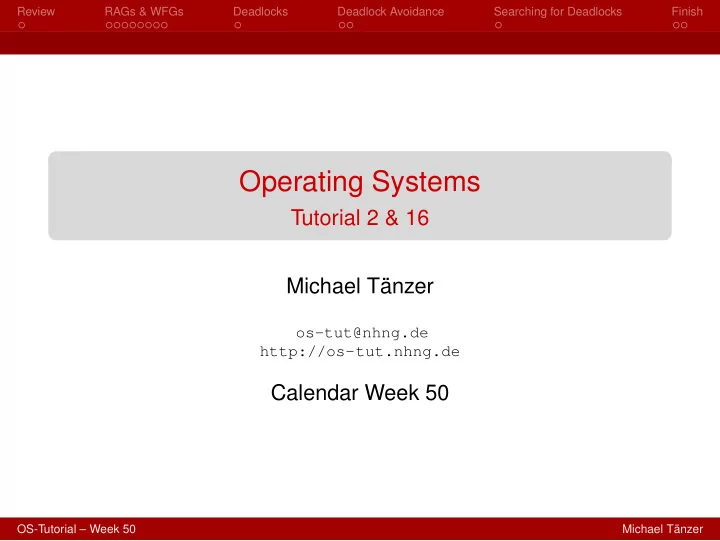

Review RAGs & WFGs Deadlocks Deadlock Avoidance Searching for Deadlocks Finish Operating Systems Tutorial 2 & 16 Michael Tänzer os-tut@nhng.de http://os-tut.nhng.de Calendar Week 50 OS-Tutorial – Week 50 Michael Tänzer
Review RAGs & WFGs Deadlocks Deadlock Avoidance Searching for Deadlocks Finish Outline Review 1 RAGs & WFGs 2 RAGs WFGs Transformations 3 Deadlocks Prerequisites Deadlock Avoidance (Banker’s Algorithm) 4 5 Searching for Deadlocks OS-Tutorial – Week 50 Michael Tänzer
Review RAGs & WFGs Deadlocks Deadlock Avoidance Searching for Deadlocks Finish True or False Progress means that a process in it’s critical section will eventually leave it On a single processor system no special atomic instructions are needed interrupts enable/disable is enough. Spinlocks are always useless as they’re doing nothing useful while waiting they should be replaced by blocking locks or semaphores. OS-Tutorial – Week 50 Michael Tänzer
Review RAGs & WFGs Deadlocks Deadlock Avoidance Searching for Deadlocks Finish RAGs Vertices Processes – represented by circles Resource types – represented by rectangles Multiple instances of a resource – a dot per instance inside the resource type vertex OS-Tutorial – Week 50 Michael Tänzer
Review RAGs & WFGs Deadlocks Deadlock Avoidance Searching for Deadlocks Finish RAGs Edges Request Edge Directed edge from a process to a resource vertex Indicates that the process wants to allocate a resource of that type Assignment Edge Directed edge from a specific instance of a resource to a process vertex Indicates that the resource is assigned to that process OS-Tutorial – Week 50 Michael Tänzer
Review RAGs & WFGs Deadlocks Deadlock Avoidance Searching for Deadlocks Finish RAGs Does a cycle in a RAG always mean the a deadlock occurred? Only if it involves resource types which only have a single instance OS-Tutorial – Week 50 Michael Tänzer
Review RAGs & WFGs Deadlocks Deadlock Avoidance Searching for Deadlocks Finish WFGs What is a wait-for graph (WFG)? A variant of a RAG Without resource vertices Edge from process P i to P j indicates that P i is waiting for a resource held by P j OS-Tutorial – Week 50 Michael Tänzer
Review RAGs & WFGs Deadlocks Deadlock Avoidance Searching for Deadlocks Finish Transformations RAG → WFG Remove resource vertices 1 Draw an edge from P i to P j if there existed an edge from P i 2 to R and from R to P j for a resource R in the RAG OS-Tutorial – Week 50 Michael Tänzer
Review RAGs & WFGs Deadlocks Deadlock Avoidance Searching for Deadlocks Finish Transformations RAG ← WFG Not possible as the information which process is allocated/waiting for what resource is not present in a WFG. OS-Tutorial – Week 50 Michael Tänzer
Review RAGs & WFGs Deadlocks Deadlock Avoidance Searching for Deadlocks Finish Transformations Can a WFG be drawn for a RAG with multiple instances per resource type? P1 P2 R1 P3 Should the edge be drawn from P 3 to P 1 or to P 2 ot to both? ⇒ Not possible OS-Tutorial – Week 50 Michael Tänzer
Review RAGs & WFGs Deadlocks Deadlock Avoidance Searching for Deadlocks Finish Transformations What can a WFG be used for? Deadlock detection Circle in WFG ⇒ deadlock occured OS-Tutorial – Week 50 Michael Tänzer
Review RAGs & WFGs Deadlocks Deadlock Avoidance Searching for Deadlocks Finish Prerequisites Explain the necessary conditions for deadlocks Give an example for how to prevent each of them Mutual Exclusion Resources can’t be shared between processes (spooling) Hold and Wait A process already holding a ressource can wait to acquire another one (allocate resources atomically) No Preemtion Resources can’t be taken away from a process by force (save/load state) Circular Wait The WFG has a circle (order resources) OS-Tutorial – Week 50 Michael Tänzer
Review RAGs & WFGs Deadlocks Deadlock Avoidance Searching for Deadlocks Finish What is a safe state? All processes can run to completion Even if each process will request the maximum number of resources Processes which can’t be granted their request have to wait for others to terminate OS-Tutorial – Week 50 Michael Tänzer
Review RAGs & WFGs Deadlocks Deadlock Avoidance Searching for Deadlocks Finish Task (a) Allocation (b) Max R 1 R 2 R 3 R 4 R 1 R 2 R 3 R 4 P 1 0 0 1 2 P 1 0 0 1 2 P 2 1 0 0 0 P 2 1 7 5 0 P 3 1 3 5 4 P 3 2 3 5 6 P 4 0 6 3 2 P 4 0 6 5 2 P 5 0 0 1 4 P 5 0 6 5 6 (c) Available R 1 R 2 R 3 R 4 1 5 2 0 What is the content of the matrix ‘Need’? Is the system in a safe state? If P 2 requests ( 0 , 4 , 2 , 0 ) should it be granted? OS-Tutorial – Week 50 Michael Tänzer
Review RAGs & WFGs Deadlocks Deadlock Avoidance Searching for Deadlocks Finish Code vulnerable to race conditions or deadlocks? Spinlock s1, s2, s3 = FREE; int counter = 0; Thread1(){ if (counter == 0){ lock(s1); counter++; unlock(s1); } lock(s2); lock(s3); /* update some more data */ unlock(s3); unlock(s2); } Thread2(){ lock(s3); counter++; /* update some data */ if (counter == 2){ lock(s2); /* update some more data */ unlock(s2); } lock(s1); /* update even more data */ unlock(s3); unlock(s1); } OS-Tutorial – Week 50 Michael Tänzer
Review RAGs & WFGs Deadlocks Deadlock Avoidance Searching for Deadlocks Finish A Quick Survey Write on an anonymous piece of paper: At least one thing you liked At least one thing that could be improved about the tutorial OS-Tutorial – Week 50 Michael Tänzer
Review RAGs & WFGs Deadlocks Deadlock Avoidance Searching for Deadlocks Finish The End The End OS-Tutorial – Week 50 Michael Tänzer
Recommend
More recommend